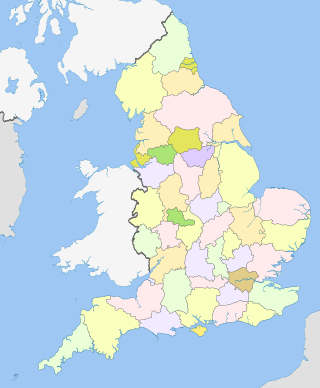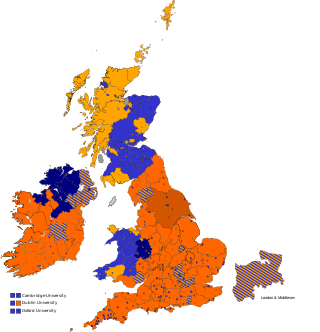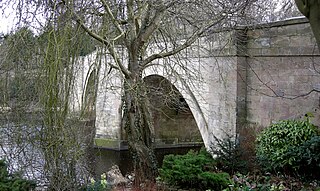
Thomas Fairfax, 3rd Lord Fairfax of Cameron, also known as Sir Thomas Fairfax, was an English politician, general and Parliamentary commander-in-chief during the English Civil War. An adept and talented commander, Fairfax led Parliament to many victories, including the crucial Battle of Naseby, effectively becoming military ruler of England, but he was eventually overshadowed by his subordinate Oliver Cromwell, who was more politically adept and radical in action against Charles I. Fairfax became dissatisfied with Cromwell's policy and publicly refused to take part in Charles's show trial. Eventually he resigned, leaving Cromwell to control the country. Because of this, as well as his honourable battlefield conduct and active role in the Restoration of the monarchy after Cromwell's death, he was exempted from the retribution that was exacted on many other leaders of the revolution.

Marmaduke Langdale, 1st Baron Langdale was an English landowner and soldier who fought with the Royalists during the Wars of the Three Kingdoms.

Ceremonial counties, formally known as counties for the purposes of the lieutenancies, are areas of England to which lord-lieutenants are appointed. They are one of the two main legal definitions of the counties of England in modern usage, the other being the counties for the purposes of local government legislation. A lord-lieutenant is the monarch's representative in an area. Shrieval counties have the same boundaries and serve a similar purpose, being the areas to which high sheriffs are appointed. High sheriffs are the monarch's judicial representative in an area.
This is a list of people who have served as Lord Lieutenant for the East Riding of Yorkshire. The office was established after the English Restoration in 1660, when a Lord Lieutenant was appointed for each Riding of Yorkshire. Since 1721, all Lord Lieutenants have also been Custos Rotulorum of the East Riding of Yorkshire, and for part of the period also Lieutenants of the Town and County of the Town of Kingston upon Hull. It was abolished on 31 March 1974 with the creation of the county of Humberside, but was re-created upon the abolition of Humberside on 1 April 1996.
Sir William Constable, 1st Baronet was an English soldier, politician and regicide, who supported the Parliamentary cause during the English Civil War and interregnum.
The post of Lord Lieutenant of the North Riding of Yorkshire was created in 1660, at the Restoration. It was abolished on 31 March 1974, and replaced with the office of Lord Lieutenant of North Yorkshire. From 1782 until 1974, all Lords Lieutenant were also Custos Rotulorum of the North Riding of Yorkshire.
This is a list of those who have held the position of Lord Lieutenant of the West Riding of Yorkshire from its creation in 1660 to its abolition on 31 March 1974. From 1699 until 1974, all Lords Lieutenant were also Custos Rotulorum of the West Riding of Yorkshire. The incumbent Lord Lieutenant became in 1974 Lord Lieutenant of West Yorkshire, covering a smaller area.
The position of Lord Lieutenant of North Yorkshire was created on 1 April 1974.
This is a list of those who have held the position of Lord Lieutenant of Cumbria. Cumbria was formed on 1 April 1974 by combining Cumberland and Westmorland, the area of Lancashire North of the Sands part of the Lonsdale Hundred and the former Sedbergh Rural District of the West Riding of Yorkshire.
This is a list of those who have held the position of Lord Lieutenant of South Yorkshire:

Yorkshire was a constituency of the House of Commons of the Parliament of England from 1290, then of the Parliament of Great Britain from 1707 to 1800 and of the Parliament of the United Kingdom from 1801 to 1832. It was represented by two Members of Parliament, traditionally known as Knights of the Shire, until 1826, when the county benefited from the disfranchisement of Grampound by taking an additional two members.
This is a list of people who have served as Custos Rotulorum of the East Riding of Yorkshire.

Viscount of Irvine was a title in the Peerage of Scotland. It was created on 23 May 1661 for Henry Ingram, of Temple Newsam, Yorkshire, and Hoar Cross Hall, Staffordshire. He was made Lord Ingram at the same time, also in the Peerage of Scotland.
The Battle of Seacroft Moor took place in Whinmoor moor near the village of Seacroft, north-east of Leeds in West Riding on 30 March 1643 during the First English Civil War. In the battle, a Parliamentarian force commanded by Lieutenant-General Thomas Fairfax was decisively beaten by a Royalist cavalry force commanded by George Goring.

Sir William Pennyman was an English landowner, soldier and politician.
Sir Thomas Ingram was an English politician who sat in the House of Commons in two periods between 1640 and 1672. He supported the Royalist cause in the English Civil War.
Sir Henry Cholmley (1609–1666) was an English politician who sat in the House of Commons at various times between 1641 and 1666. He supported the Parliamentary cause in the English Civil War.
The battle of Leeds took place during the First English Civil War on 23 January 1643, when a Parliamentarian force attacked the Royalist garrison of Leeds, Yorkshire. The attack was partly dictated by the need to maintain local support for the Parliamentarian cause; the Earl of Newcastle had recently shifted the balance of power in Yorkshire in the Royalists' favour with the addition of his 8,000-strong army, and sent one of his commanders, Sir William Savile to capture Leeds. The West Riding of Yorkshire relied on the cloth trade, and Ferdinando, Lord Fairfax sent his son, Sir Thomas Fairfax to bolster the defences of nearby Bradford, before agreeing to his request to attack Leeds.
The Battle of Tadcaster took place during the First English Civil War on 7 December 1642, when a Royalist force attacked the Parliamentarian garrison of Tadcaster, Yorkshire, which was held by between 900 and 1,500 soldiers under the command of Ferdinando Fairfax, Lord Fairfax. The Earl of Newcastle marched out of York on 6 December, and split his force of 6,000 into two; he took 4,000 infantry down the main York–Tadcaster road to attack the town from the east, while sending a deputy, the Earl of Newport, with a further 1,500 to circle around and trap the Parliamentarians by attacking from the north-west.

The battle of Piercebridge was fought on 1 December 1642 in County Durham, England, during the First English Civil War. The Earl of Newcastle was advancing with an army of 6,000 from Newcastle upon Tyne to York to reinforce the local Royalists. Aware of his approach, the Parliamentarians defended the main crossing over the River Tees, at Piercebridge. Under the command of Captain John Hotham, around 580 troops had barricaded the bridge.













